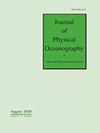Structures of Lateral flow and turbulence in a breaking tidal bore rushing through a curved channel of the Qiantang Estuary
IF 3
2区 地球科学
Q1 OCEANOGRAPHY
引用次数: 0
Abstract
Tidal bores form in funnel-shaped estuaries and bays initially and cause unique flow and turbulence dynamics when passing through meandering channels, such as in the Qiantang Estuary, Amazon River Estuary, and Seine River Estuary. To understand the lateral currents and turbulence processes of tidal bores in curved channels, velocity profiles and free-surface elevations are sampled for four semidiurnal tidal cycles in a curved channel located upstream of the Qiantang Estuary. During flood tides, the evolution of lateral currents experiences three distinct phases: first, there are inner-bank-toward lateral currents at the front of tidal bores, followed by two-layer helical currents in the middle of the flood tides, and finally, outer-bank- pointing lateral currents at the end of flood tides. Tidal bore breaking creates outbursts of turbulent kinetic energy. The enhanced turbulence emerges above the middle layers and persists for more than ten minutes after the breaking front. The lateral momentum balance indicates that the decreasing lateral barotropic pressure gradient (LBTPG) and the increasing summation of centrifugal and Coriolis acceleration give rise to the variation in lateral currents. The phase lead of bores near the outer bank induced by shoal-channel topography generates inner-bank pointing LBTPG at the bore front and then gradually weakens it. Significant turbulence following bore breaking may be induced via the wave-induced turbulence mechanism by violent secondary waves. This research shows that complicated lateral currents are an important component of tidal bores flowing through meandering channels and that secondary waves after bore breaking can continually feed turbulence.钱塘江河口弯曲河道断潮孔中的侧向流和湍流结构
潮孔最初形成于漏斗形河口和海湾,在通过蜿蜒的河道(如钱塘江河口、亚马逊河河口和塞纳河河口)时,会产生独特的水流和湍流动力学。为了了解弯曲河道中潮水渠的侧向流和湍流过程,我们在钱塘江河口上游的弯曲河道中对四个半日潮周期的流速剖面和自由表面高程进行了采样。在洪潮期间,侧向流的演变经历了三个不同的阶段:首先是潮孔前端的内滩向侧向流,其次是洪潮中期的两层螺旋流,最后是洪潮末期的外滩指向侧向流。潮孔破裂会产生湍流动能的爆发。增强的湍流出现在中层之上,并在断裂前沿之后持续十多分钟。侧向动量平衡表明,侧向气压梯度(LBTPG)的减小以及离心加速度和科里奥利加速度总和的增加导致了侧向流的变化。由浅滩-河道地形引起的靠近外滩的镗孔相位领先,在镗孔前沿产生指向内滩的 LBTPG,然后逐渐减弱。通过波浪诱导湍流机制,剧烈的次生波可能会在镗孔断裂后诱发显著的湍流。这项研究表明,复杂的侧向流是流经蜿蜒水道的潮汐镗孔的重要组成部分,镗孔断裂后的次生波会持续不断地引发湍流。
本文章由计算机程序翻译,如有差异,请以英文原文为准。
求助全文
约1分钟内获得全文
求助全文
来源期刊
CiteScore
2.40
自引率
20.00%
发文量
200
审稿时长
4.5 months
期刊介绍:
The Journal of Physical Oceanography (JPO) (ISSN: 0022-3670; eISSN: 1520-0485) publishes research related to the physics of the ocean and to processes operating at its boundaries. Observational, theoretical, and modeling studies are all welcome, especially those that focus on elucidating specific physical processes. Papers that investigate interactions with other components of the Earth system (e.g., ocean–atmosphere, physical–biological, and physical–chemical interactions) as well as studies of other fluid systems (e.g., lakes and laboratory tanks) are also invited, as long as their focus is on understanding the ocean or its role in the Earth system.

 求助内容:
求助内容: 应助结果提醒方式:
应助结果提醒方式:


